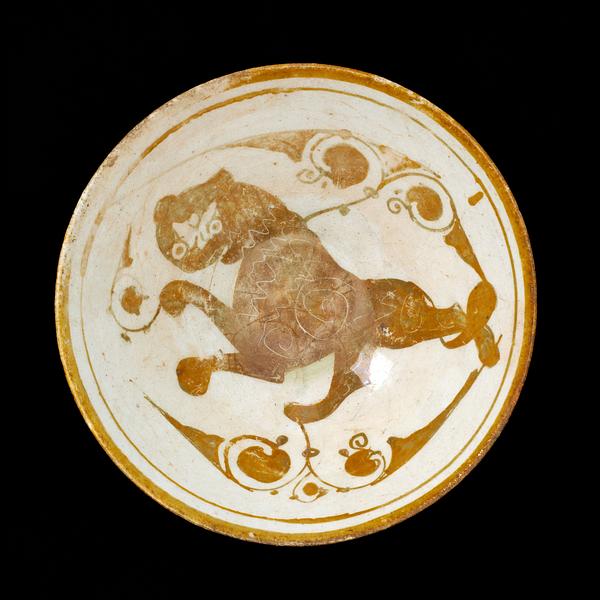Fritware bowl, decorated in lustre over a transparent glaze. Tell Minis type
Syria; c. 1150
H: 6.2; Diam: 19.5 cm
Lions and animal-combat motifs are frequently found in Islamic art. They are often symbols of power and were adopted from an ancient Middle Eastern tradition.
The lion on this bowl, however, was depicted in a distinctive, almost humoristic way that is characteristic of ceramics of the Tell Minis type. The animal has humanlike features and a prominent chest, and is shown standing on its hind legs, its head in three-quarter profile.
Because of its decoratively curved legs, the lion points to the type of elegant animal depictions that were soon painted on Syrian pottery in Raqqa.
Raqqa ware did not, however, adopt another detail that is characteristic of the Tell Minis type. Rather than being isolated ornaments, the palmettes around the lion are linked with fine lines to its legs.
Inv. no. D 74/1986
Published in:
C .L. Davids Samling. Fjerde Del : Jubilæumsskrift 1945-70, København 1970, fig. 4, p. 263;
The arts of Islam : Hayward gallery, 8 April - 4 July 1976, London 1976, cat.no. 298;
Art from the World of Islam. 8th-18th century, Louisiana, Humlebæk 1987, cat.no. 56;
Venetia Porter and Oliver Watson: "”Tell Minis" wares” in Oxford studies in Islamic art, 4, 1987, p. 208, cat.no. A9 and p. 223;
Kjeld von Folsach: Islamic art. The David Collection, Copenhagen 1990, cat.no. 88;
Kjeld von Folsach: Art from the World of Islam in The David Collection, Copenhagen 2001, cat.no. 140;
Almut v. Gladiss (ed.): Die Dschazira: Kulturlandschaft zwischen Euphrat und Tigris, Museum für Islamische Kunst, Berlin 2006, cat.no. 11, p. 52;
Alexander Schubert (ed.): Richard Löwenherz: König - Ritter – Gefangener, Historisches Museum der Pfalz Speyer, Regensburg 2017, cat.no. 80;
Farzaneh Pirouz-Moussavi: Cerámica entre dos mares: De Bagdad a la talavera de Puebla = Clay between two seas: from Baghdad to the talavera of Puebla, Museo Franz Mayer, Mexico 2017, p. 54;
